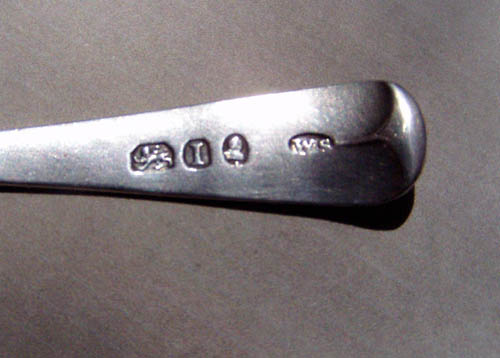This is my first posting as I begin to learn more about hallmarks. The picture below comes from a teaspoon. As you can see there are marks for the Lion passant, date (‘I’), duty (which I believe is George III) and maker (‘WS’ - William Shaw or William Sumner?) Both these makers are associated with London … BUT, there is no town mark! Can anyone help educate me on this matter? Best wishes from Canberra on Australia Day (26 Jan). Peter.

Hi Peter, thanks for joining us on silver-collector.com.
Small articles which fall below a certain weight are not subject to quite the same hallmarking law as larger articles, and so only have to be part marked, i.e marked with the sterling mark to show they have been tested for purity, the date letter to show the year of manufacture, and (in this case) the duty mark to show duty had been paid. The makers mark was stamped by the maker and so would always appear.
This was often the case on teaspoons, especially from this period as silversmiths kept the weight low to avoid large duty bills.
Basically its nothing to worry about!
Best regards
Daniel
Thanks, Daniel. Advice and addition to my understanding of it all is much appreciated. Best wishes. Peter
Hi again Daniel. I have a follow-up question in relation to this marking. My pocket edition of ‘Jackson’s Hallmarks’ shows that there was a change in the duty mark in the course of 1804-5 (at the London assay office). Mid-year changes also occurred at other times in this Georgian period. Why is it so? Cheers. Peter
Hi again Peter,
The change in the shape of the duty mark corresponds to changes in the amount of duty that was applied on silver.
This occurred on the 6 July 1797 (when the duty doubled from 6d per ounce to 1s per ounce), and on the 11 October 1804 (from 1s per ounce to 1s 3d per ounce). During the year 1815-1816 three different shield shapes were used, due to changes occurring on the 14 June (due to a change in the regulations for the refund of duty), and on the 1 September (when the duty increased to 1s 6d per ounce).
Let me know if I can be any further help,
Best regards
Daniel
Fascinating! Thanks, Daniel. I’m sure I’ll be back with more questions; perhaps in relation to three more spoons that I found today, I think from the mid-eighteenth century. Best wishes. Peter
As I understand it, from 1781 London spoons (beginning with the letter f) were struck with a stub (a punch containing a group of marks) which superseded the customary use of individual marks (not including the maker’s mark).
When the octagonal King’s head duty mark was introduced on 1st December 1784, it was again punched separately. It wasn’t until the introduction of the cameo King’s head of 1786 that the duty mark was included in the stub.
Thereafter, all London marks on flatware are struck with a stub, with, of course, the exception of teaspoons!